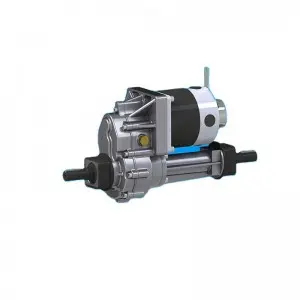What Should I Check If My Electric Transaxle Is Making a Grinding Noise?
If your electric transaxle is making a grinding noise, it’s crucial to address the issue promptly to prevent further damage and costly repairs. Here’s a comprehensive checklist to help you diagnose and resolve the problem:
1. Check the Transmission Fluid
1.1 Fluid Level
Low fluid level can cause grinding noises due to insufficient lubrication and increased friction. Check the fluid level using the dipstick or inspection plug when the transmission is warm. If the fluid is low, top it up with the correct type of fluid.
Fluid leaks can lead to low fluid levels. Common leak points include the pan gasket, oil pan punctures, O-rings, transmission lines, and seals. Identifying and repairing leaks is crucial to prevent further fluid loss.
1.2 Fluid Quality
Degraded or contaminated fluid can also cause grinding noises. Check the fluid for a dark color, burned smell, or debris. If the fluid appears dirty or contains particles, it may need to be drained and replaced.
2. Inspect the Gears and Bearings
2.1 Gear Wear
Worn gears can cause grinding noises, especially when shifting gears. This is common in both manual and automatic transmissions. A visual inspection of the gears can reveal signs of wear or damage.
2.2 Bearing Wear
Worn bearings inside the transmission can produce humming or buzzing noises, which may be mistaken for grinding. Inspect the bearings for signs of wear or damage.
3. Check the Clutch and Synchronizers (Manual Transmissions)
3.1 Clutch Wear
Worn clutch in manual transmissions can cause grinding noises when shifting gears. If the clutch is worn out, it may need to be replaced.
3.2 Synchronizer Wear
Worn synchronizers (or synchros) can also cause grinding noises. These components help match the speeds of the gears during shifting. If they are worn, the gears may not engage smoothly.
4. Inspect the Torque Converter (Automatic Transmissions)
4.1 Torque Converter Damage
Worn or damaged torque converter can produce grinding noises in automatic transmissions. If the torque converter is faulty, it may need to be replaced. The cost of replacing a torque converter can range from $450 to $600.
5. Check the Transmission Mounts
5.1 Loose or Damaged Mounts
Loose or broken transmission mounts can cause clunking or grinding noises. These mounts hold the transmission in place, and if they are damaged, they can lead to misalignment and increased vibration. Replacing damaged mounts can be a simple and cost-effective solution.
6. Inspect the Valve Body
6.1 Clogged or Dirty Valve Body
Clogged valve body can cause delayed gear engagement and grinding noises. The valve body controls fluid pressure and gear shifts. If it is contaminated with debris, it may need to be cleaned or replaced. This is a job best handled by a transmission specialist.
7. Check for Software Issues
7.1 Software Diagnostics
Software diagnostics can provide valuable insights into the performance of your electric transaxle. Modern diagnostic tools can detect issues before they become severe. Ensure your transaxle software is up to date, as updates can improve performance and fix bugs.
8. Inspect the Motor Mountings
8.1 Damaged Motor Mounts
Damaged or worn-out motor mounts can lead to misalignment and increased vibration, which may cause grinding noises. Replacing these mounts can extend the life of your transaxle.
9. Check for Electrical Issues
9.1 Faulty Shift Solenoids
Faulty shift solenoids can cause trouble changing gears and produce grinding noises. These solenoids control the flow of transmission fluid. If they are stuck or broken, they may need to be replaced.
10. Professional Inspection and Diagnosis
10.1 Professional Help
If you are unable to identify the issue or if the problem persists after initial checks, it is advisable to seek professional help. Most manufacturers offer detailed troubleshooting guides and support hotlines. A professional mechanic or transmission specialist can perform a thorough inspection and provide a precise diagnosis.
Conclusion
A grinding noise from your electric transaxle is a clear indication that something is wrong and requires immediate attention. By following this checklist, you can identify potential issues and take appropriate action to prevent further damage. Regular maintenance, such as checking fluid levels and quality, inspecting gears and bearings, and ensuring proper alignment, can significantly extend the life of your transaxle and improve overall vehicle performance
Post time: Feb-10-2025


